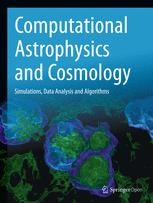Researchers have created a virtual reality simulation of a supermassive black hole
 The black hole at the centre of our galaxy, Sagittarius A*, has been visualised in virtual reality for the first time. The details are described in an article published in the open access journal Computational Astrophysics and Cosmology.
The black hole at the centre of our galaxy, Sagittarius A*, has been visualised in virtual reality for the first time. The details are described in an article published in the open access journal Computational Astrophysics and Cosmology.
Scientists at Radboud University, The Netherlands and Goethe University, Germany used recent astrophysical models of Sagittarius A* to create a series of images that were then put together to create a 360 degree virtual reality simulation of the black hole, that can be viewed on widely available VR consoles. The authors suggest that this virtual reality simulation could be useful for studying black holes.
Jordy Davelaar, Thomas Bronzwaer, Daniel Kok, Ziri Younsi, Monika Mościbrodzka and Heino Falcke, "Observing supermassive black holes in virtual reality", Comput. Astrophys. Cosmol. (2018) 5:1 https://doi.org/10.1186/s40668-018-0023-7
Jordy Davelaar, corresponding author, said: “Our virtual reality simulation creates one of the most realistic views of the direct surroundings of the black hole and will help us to learn more about how black holes behave. Traveling to a black hole in our lifetime is impossible, so immersive visualizations like this can help us understand more about these systems from where we are.”
The authors also suggest that the virtual reality simulation could help encourage the general public, including children, to take an interest in astrophysics.
Davelaar said: “The visualisations that we produced have a great potential for outreach. We used them to introduce children to the phenomenon of black holes, and they really learned something from it. This suggests that immersive virtual reality visualizations are a great tool to show our work to a broader audience, even when it involves very complicated systems like black holes.”
Heino Falcke, Professor at Radboud University adds: “We all have a picture in our head of how black holes supposedly look, but science has progressed and we can now make much more accurate renderings – and these black holes look quite different from what we are used to. These new visualisations are just the start, more to come in the future.“
The video, which can be viewed with or without VR, can be downloaded here. Images of the simulation can be downloaded here (Credit J.Davelaar 2018).
Media Contacts
Lucy Eccles
Communications Officer, BMC
T: +44 (0)20 3192 5730
E: Lucy.Eccles@biomedcentral.com
1. Research article:
Observing Supermassive Black Holes In Virtual Reality
Davelaar et al. Computational Astrophysics and Cosmology 2018
DOI: 10.1186/s40668-018-0023-7
The article is available on the journal website.
Please name the journal in any story you write. If you are writing for the web, please link to the article. All articles are available free of charge, according to BMC's open access policy.
2. Computational Astrophysics and Cosmology opens new windows in the way we perceive and study the heavens. This rapidly growing new discipline in astronomy combines modern computational methods, novel hardware design, advanced algorithms for simulations and data analysis, original software implementations and associated technologies to discover new phenomena, and to make predictions in astronomy, cosmology and planetary sciences.
3. The research was made possible by the ERC Synergy grant titled ‘BlackHoleCam given to Heino Falcke (Radboud University), M. Kramer (Max Planck Institute for Radioastronomy), L. Rezzolla (Goethe University Frankfurt).
4. A pioneer of open access publishing, BMC has an evolving portfolio of high quality peer-reviewed journals including broad interest titles such as BMC Biology and BMC Medicine, specialist journals such as Malaria Journal and Microbiome, and the BMC series. At BMC, research is always in progress. We are committed to continual innovation to better support the needs of our communities, ensuring the integrity of the research we publish, and championing the benefits of open research. BMC is part of Springer Nature, giving us greater opportunities to help authors connect and advance discoveries across the world.
[republished from: https://www.biomedcentral.com/about/press-centre/science-press-releases/researchers-have-created-a-virtual-reality-simulation-of-a-super]
